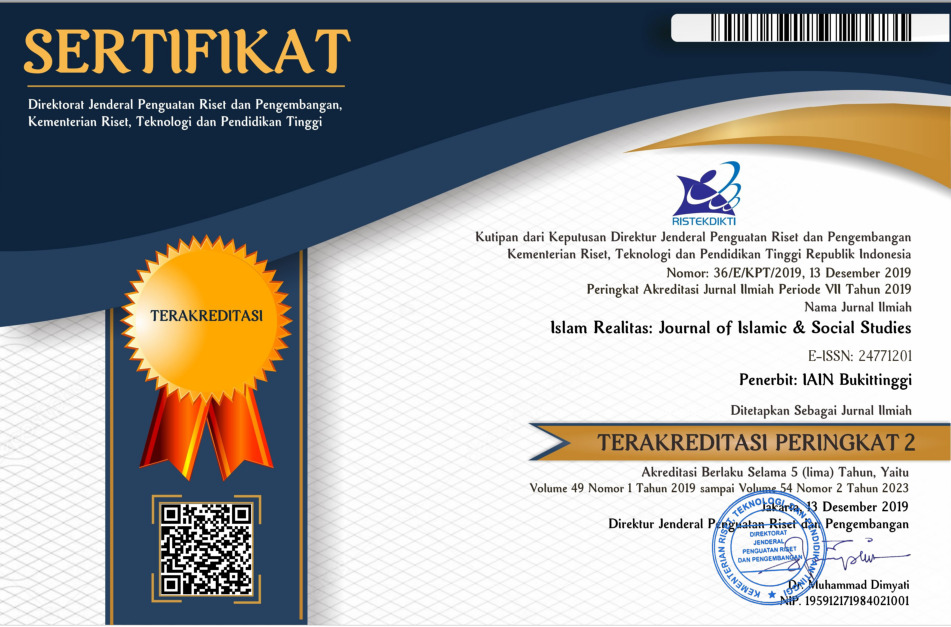Relasi Agama dan Negara dalam Gerakan Keagamaan Baru: Studi Kasus Komunitas Here Krisna Yogyakarta
DOI:
https://doi.org/10.30983/fuaduna.v3i2.2513Abstract
References
Aryono. “Pergulatan Aliran Kepercayaan Dalam Panggung Politik Indonesia, 1950an-2010an: Romo Semono Sastrodihardjo Dan Aliran Kapribadenâ€, Jurnal Sejarah Citra Lekha 3, no. 1 (2018): 60.
Bauto, Laode Monto. “Perspektif Agama Dan Kebudayaan Dalam Kehidupan Masyarakat Indonesiaâ€, Jurnal Pendidikan Ilmu Sosia 23, no. 2 (Desember, 2014), 14.
Budiyono. “Hubungan Negara dan Agama Dalam Negara Pancasilaâ€, Jurnal Ilmu Hukum 8, no. 3, (2014): 410-415.
Christianto, Hwian. “Arti Penting Uu No. 1/Pnps/1965 Bagi Kebebasan Beragamaâ€, Jurnal Yudisial 6, no. 1 (April, 2013): 9-10.
Fajarini, Ulfah. “Potret Konflik Keagamaan Masyarakat Tangerang Banten Dan Resolusi Konflik Berbasis Multikulturalisme Dalam Islamâ€, Jurnal Al-Tahrir 14, no. 2 (Mei, 2014): 349.
Hakiki, Kiki Muhamad. “Politik Identitas Agama Lokalâ€, Jurnal Analisis XI, no. 1 (Juni, 2011): 160-161.
Howell, Julia D. “Muslims, the New Age and Marginal Religions in Indonesia: Changing Meanings of Religious Pluralismâ€, Jurnal Social Compas 52, no. 4 (2005): 474.
Kotimah. “Agama dan Civil Societyâ€, Jurnal Ushuluddin XXI, no. 1 (Januari 2014): 123.
Langaji, Abbas. “Dinamika Aliran Keagamaan Sempalan: Tinjauan Perspektif Sosiologi Agamaâ€, Jurnal Hikmah XII, no. 1 (2016): 141.
Mertamupu, I Ketut. “Ajaran Agama Hinduâ€,https://www.kompasiana.com/mertamupu/55176548a33311b906b6603b/inti-ajaran-hindu diakses tanggal 2 Mei 2019
Raharja, Budi. Pengasuh Ashram Hare Krisna Yogyakarta), di Sleman Yogyakarta, Wawancara tanggal 18 April 2019.
Suhanah. “Kelompok Spritual Sakkhi dan Dampak Terhadap Kehidupan Keagamaan di Indonesiaâ€, Jurnal Multikultural dan Multireligius 15, no. 3 (2016): 3.
Takdir, Mohammad. "New Spiritual Movement: Menelisik Visi Transpormatif Komunitas Lia Eden sebagai Embrio lahirnya New Age di Indonesia", 3.
Zuchairiyah, Rofiqoh. “Kekerasan Terhadap Pengikut Aliran Yang Dinilai Sesat Dalam Perspektif Hukum Islamâ€, Jurnal Agama Dan Hak Azazi Manusia 1, no. 2 (Mei, 2012): 369-370.
Downloads
Published
How to Cite
Issue
Section
Citation Check
License
Authors who publish with this journal agree to the following terms:
- Authors retain copyright and grant the journal right of first publication with the work simultaneously licensed under a Creative Commons Attribution-ShareAlike 4.0. that allows others to share the work with an acknowledgment of the work's authorship and initial publication in this journal.
- Authors are able to enter into separate, additional contractual arrangements for the non-exclusive distribution of the journal's published version of the work (e.g., post it to an institutional repository or publish it in a book), with an acknowledgment of its initial publication in this journal.
- Authors are permitted and encouraged to post their work online (e.g., in institutional repositories or on their website) prior to and during the submission process, as it can lead to productive exchanges, as well as earlier and greater citation of published work (See The Effect of Open Access).





